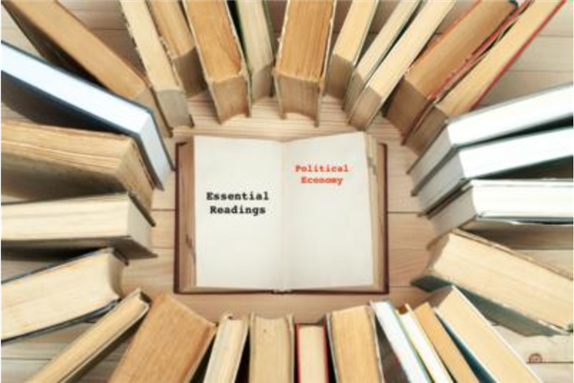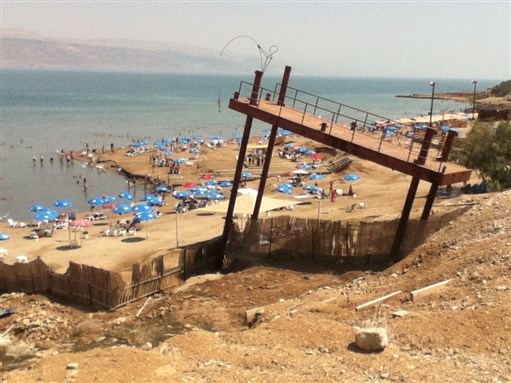Fazal Sheikh and Eyal Weizman, The Conflict Shoreline (Steidl, 2015); Diana Davis, The Arid Lands (MIT, 2016); Salvatore Engel-Di Mauro, Ecology, Soils, and the Left (Palgrave, 2014).
David G. Hogarth was a turn of the twentieth century archaeologist. He was also an archetype of the British Orientalist. In The Nearer East, a book which did excellent labor justifying colonial rule, he wrote that the nomads “impoverish the land [in Palestine] and lightly abandon it to denudation and sand-drift…The Bedawin [sic], born of the desert, becomes in turn its creator.” The causal claim was totally untrue. But it informed the ongoing takeover of Palestine. And similar kitsch is in use to justify the ongoing dispossession of those same Bedouins in al-Naqab – the Negev.
The Conflict Shoreline, a collaboration of Fazal Sheikh and Eyal Weizman, discusses this ongoing colonial usurpation of al-Naqab – the Negev, tracing it from the prestate period until the present. Sheikh’s contribution is a series of stunningly composed aerial photographs of the region – the beige and light brown of cleansed native settlements and military firing ranges – taken in the fall of 2011. Sometimes, the authors contrast the evidence from these photos with the black, white, and grey eraser smudges of British wartime aerial photography. Weizman’s written accompaniment is a forensic examination of the area. He charts shifts in its political ecology, and chronicles attempts to define the livable limits of that ecology.
The frontier between Israeli sovereignty and Bedouin land claims is “a seam between two climatic conditions,” the 200mm of annual precipitation isohyet, the minimum considered “arable” without irrigation, and that which is “desert.” Although the Bedouin have extensive technologies for irrigation using rainwater, “the threshold of aridity thereafter marked the border of a zone of expropriation within which the Bedouins were put completely at the mercy of the state and tolerated only as a matter of charity.”
The conversion of the Bedouin into objects of state charity, explains Weizman, was justified by a colonial narrative of decline in which the Arab conquest of the area led to the abandonment of agricultural settlements. But the Bedouin were the ones who had preserved long-standing local knowledge of low-rainfall agricultural technology, albeit using that technology at a lower level of intensity than during previous periods. The Bedouin had ignored Ottoman and British attempts to register their claims on the land. To register would have been to submit to the taxation of the central state. Such state evasion was a boon during attempts to avoid extractive exactions from the Ottomans, and then the British. But it became a burden during the colonial settlement, allowing Zionists to claim the Bedouin had no claims to the land. The colonizing project displaced 100,000 people from 1948-1953. It then justified this dispossession through the “dead lands” doctrine, according to which the land was non-arable because it was desert. QED.
A small lapse is that Weizman occasionally accepts international institutions’ concepts of desertification at face value. In The Arid Lands, Diana Davis offers a wide-ranging criticism of such notions. She expands on her previous groundbreaking work on the definition of deserts under French colonialism in North Africa. She here traces the genealogy of such notions of “desertification.” According to a metastatic notion common amongst colonizers, some developing states, and a great many of the global North-dominated international institutions, much of the world’s arid lands – thirty-five to fifty percent of the planet – are vulnerable to or undergoing “desertification.” This is supposedly due to overgrazing from pastoral people. During the colonial period, such notions justified expropriation of land on the grounds that roving nomads were not working it intensely enough. Another alibi was that they had entirely ruined previously forested regions.
Such thought took formal form in “dessication theory”: the notion that the inhabitants were responsible for the desert’s fall from afforested grace. Its upshot was that human improvement could restore these lands to fertility. Indeed, many sought to restore it to “productivity according to capital goals,” often by planting forests. In fact, as Davis shows, such forests damage the water table and do far more damage to these lands than the mélange of transhumanism and rainfall-dependent irrigation which traditional users of the land did and still do deploy.
The crucible for these ideas’ growth was the expansive growth of capitalism and colonialism, and the Lockean notion of improvement conferring ownership of land. Such notions justified enclosure at home and the great enclosure of colonialism abroad. But although Davis grounds this genealogy historically, sometimes an anti-Orientalist analytic lingers. She traces a textual thread of problematic Western notions of the desert, as though the idea was just waiting for material reality to allow it to flourish. This approach can border on a negative teleology. In any case, by the nineteenth century, amidst a drive to accumulate land, anti-nomad sentiment was omnipresent. Colonizers blamed nomads for the deserts and drylands which they sought to settle and conquer, from Tunisia and Algeria – as Davis has noted previously – to Palestine. Once declared bad for the land, traditional uses could be made increasingly illegal, opening the door for a legal justification for instituting private property rights and erasing “indigenous communal land tenure.”
Davis is the rare social scientist who has the gift of traversing the social-natural disciplinary boundary. Few who write on agriculture or political ecology ground themselves in the natural sciences as has Davis – although more of it could have made its way into the book. This question, of social scientists’ troubled engagement with the life sciences, is central to Salvatore Engel-Di Mauro’s difficult Ecology, Soils, and the Left. Engel-Di Mauro focuses on that thin substrate that makes human life and institutions of trade and power possible: the soil.
The book is a critical tour-de-force, informed by deep expertise in soil science. Thus armed, the author is prepared to disassemble the assumptions underlying the work of soil scientists’ and social scientists alike. He criticizes the former for their pretensions to value-neutrality and the latter for a lack of attention to the processes which “occur independently of humans’ understandings of them.”
One key contribution is the discussion of soil-preservation practices and alarmist notions of “peak soil,” a notion which flourished in the 2000s, referring to peaking amounts of arable land per person. Here the author illustrates the one-two punch of expertise in the relevant literature and a decolonial and anti-capitalist politic. He first shows how peak soil sidesteps human ability to both form and conserve soils. In turn, he suggests that “it would be more reasonable to learn from existing conservation practices and to facilitate their strengthening or diffusion in rune with ecosystems and social context.” This is a call for science, in effect, from the people, and the local and tacit knowledges they deploy in their everyday practice.
Another example of the author`s adeptness in multiple disciplines is his analysis of soil degradation. It happens, but what does that mean? For mainstream scientists, soil quality is good when it can support organisms, process exchanges of matter, and provide habitat. But as with the arid lands, what kind of habitat, and for whom? Desertification is by and large, actually a construct of value-laden science. Land great for grazing may be useless for high-input commercial farming, but often scientists simply assume that the land will be for the latter, and assess soil quality accordingly. But that assumption is only brought to light when one has unpacked the analyses and analyzed the metrics of mainstream science, an impossibility without an immersion in that science itself.
This does not mean an end to disciplines (or at least all disciplines) but means that we should read more science, a point Engel-Di Mauro elucidates by showing rather than telling – and doing so with rare, and occasionally overwhelming, depth.




small.jpg)








.jpg)

.jpg)




